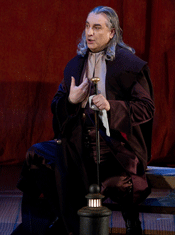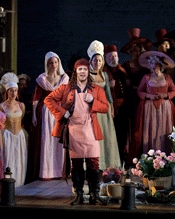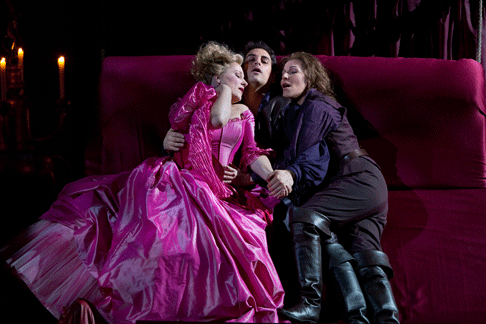You could make a case for
adding supernatural scamps like Der Vampyr and Tannh‰user to
the list. The hero may be a rogue—in fact, rogue is his job
description—and may even be a cutthroat or worse, but he’s a
lovable fellow for all that. And he almost never gets to home plate with the
ladies whose hearts he flutters; the censors wouldn’t have stood for it.
Thus the joke of Gilbert and Sullivan’s spoof in The Pirates of
Penzance: Their chorus-full of reckless rogues lust “to be married
with impunity” to the bevy of helpless females they are about to abduct.
(Is it coincidence that most of the sexy scoundrel operas are French? No.)
 Michele Pertusi as The Tutor
Michele Pertusi as The Tutor
The censors wouldn’t have stood for it then, but there are no censors
now, and opera directors are all for full disclosure. This mars Bartlett
Sher’s colorful if bare-bones staging of Le Comte Ory for the
Met. Consider the final trio: Ory, our scoundrel, has disguised himself as a
nun in order to enter Countess AdËle’s bed in her darkened chamber.
Unbeknownst to him (but obvious enough to us), AdËle’s young suitor,
Isolier, is also present, and in fact the Count is embracing Isolier as Isolier
embraces AdËle. If this seems a bit racy for 1828, even in Paris, ne
vous-inquiËtez pas: Isolier is played by a mezzo soprano. Audiences
didn’t mind watching a man fiddle with a boy so long as the boy was
obviously a woman. (The first time I saw this opera, Lucky Pierre—sorry,
Isolier—was played by a countertenor; he seemed to be enjoying the
situation.)
But in Sher’s production, all three persons scramble around each other
among the bedclothes as if this were just an ordinary three-way with no story
to tell, and it is impossible for the Count not to be aware that he is
in bed with two other people. AdËle, too, should not be aware of what is going
on; here she’s a merry participant. It may seem a small point, and
everybody around me found the slapstick hilarious, but the premises of farce
must be taken seriously for the mad machine to work properly. Either Joyce
DiDonato is a man or she isn’t; if she isn’t, why does AdËle hope
to marry her? If she is, why does the skirt-chasing Count enjoy being in bed
with him? It’s as if Lucy schemed to divorce Desi and demanded custody of
his band: It violates the clear farcical contract for which we have been so
carefully set up.
 StÈphane Degout as Raimbaud
StÈphane Degout as Raimbaud
Sher, as in his previous Met shows, Barbiere and Hoffmann,
is always willing to dump the plot to insert a dumb joke; this was also true in
his disastrous staging of Women on the Verge of a Nervous Breakdown.
He only seems capable of theatrical discipline if the piece is, like South
Pacific, sacrosanct, guarded by those who can keep him in line. He has no
theatrical clarity of his own. Is this sort of anything-for-a-laugh mayhem what
Peter Gelb means when he refers to a “new realism” in the opera
house?
The singers have been encouraged not to play this charming piece straight. I
would find the evening pleasanter (and probably funnier) if Diana Damrau, a
fine singer as well as a fine comic actress, sang the dizzy Countess’s
fruity tunes with a bit more attention to proper line and with fewer wildly
mugged high notes, and if Juan Diego FlÛrez’s nasal tenor, never the most
sensuous of instruments, were not quite so dry. He is choosing roles lately
that do not exhibit his extraordinary virtuosity, and his is not an instrument
to make it in bel canto otherwise. There are many far prettier tenor
voices around.
 Diana Damrau as Countess Adèle, Joyce DiDonato as Isolier, and Juan Diego FlÛrez as Count Ory
Diana Damrau as Countess Adèle, Joyce DiDonato as Isolier, and Juan Diego FlÛrez as Count Ory
What, I wonder, would Rothenberger and Gedda have made of the bedroom trio?
With, say, Teresa Berganza as Isolier? I can’t help thinking they’d
have each contrived to keep one foot on the floor, in old-time Hollywood
fashion, but they would still have been funnier than Sher’s
staging, and they would have sounded like a glimpse of heaven.
Joyce DiDonato, as Isolier, is a lovely performer who does not let her
farce-making get in the way of torrents of beautiful Rossini, as heartfelt as
they are pure. She is the reason to visit Le Comte Ory and the reason
to linger to the very end. Susanne Resmark revealed a most attractive alto
voice with more to display than was evident here in the Margaret Dumont-like
housekeeper role. Michele Pertusi was all that could be desired as the Tutor
and StÈphane Degout filled our grateful ears with dark baritone during his
drinking song. Maurizio Benini kept the orchestral sound low so as not to
interfere with singers’ audibility, though as Sher (as usual) pushed them
all to the edge of the stage apron, this was probably unnecessary. In the old
days, and not so very old either, singers could fill the Met from mid-stage and
revel in the filling.
John Yohalem
image=http://www.operatoday.com/COMTE_ORY_Florez_as_title_r.gif
image_description=Juan Diego FlÛrez as Count Ory (disguised as the Nun) [Photo by Marty Sohl courtesy of The Metropolitan Opera]
product=yes
product_title=Gioachino Rossini: Le Comte Ory
product_by=Comtesse AdËle: Diana Damrau; Isolier: Joyce Di Donato; Comte Ory: Juan Diego FlÛrez; Ragonde: Susanne Resmark; Tutor: Michele Pertusi; Raimbaud: StÈphane Degout. Production by Bartlett Sher. Metropolitan Opera chorus and orchestra conducted by Maurizio Benini. Performance of March 24.
product_id=Above: Juan Diego FlÛrez as Count Ory (disguised as the Nun)
All photos by Marty Sohl courtesy of The Metropolitan Opera